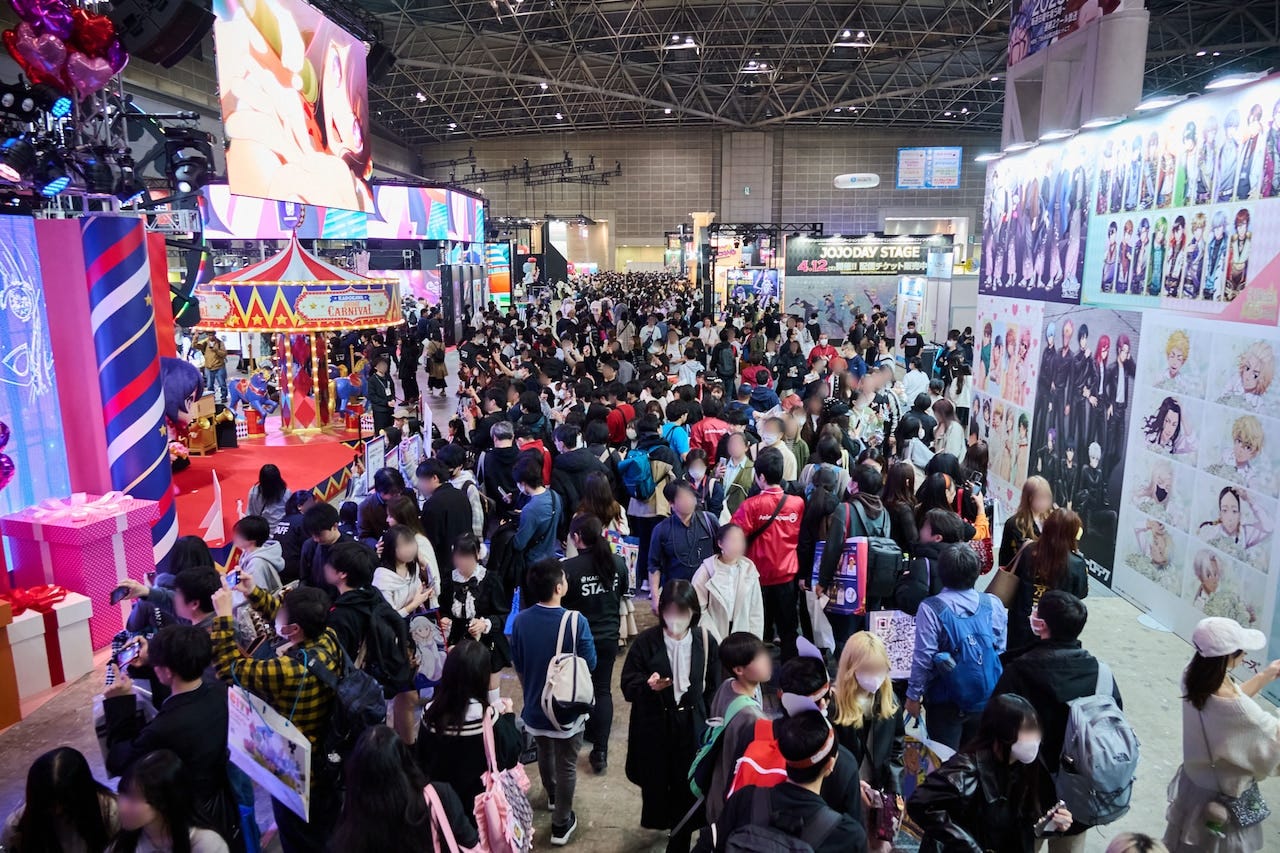Anime enthusiasm at AnimeJapan hits new peak
Plus: Niigata animation fest wants more original films; Second screens drive up views of English anime dubs; Homegrown anime software tackle digital deficit; and more
This is your weekly Animenomics briefing, covering the business of anime and manga. Today is Wednesday, March 26, 2025.
In case you missed it: The Royal Shakespeare Company’s stage play My Neighbour Totoro, based on director Hayao Miyazaki’s anime film, will extend its current third run in London’s West End through March 2026, past its initial November end date.
Totoro’s stage play has won six Laurence Olivier Awards, the most prestigious awards in British theater.
AnimeJapan attendance, business activity see recovery

Attendance at Tokyo’s annual AnimeJapan trade exhibition last weekend returned to its pre-pandemic peak, recorded in 2018, with visitors from outside Japan making up 10 percent of all attendees as global interest in anime continues to climb.
Why it matters: Consumer enthusiasm for anime and its products is good news for producers and licensees who returned to in-person dealmaking activities this year.
About 60 Japanese and foreign firms ran booths on AnimeJapan’s business days, the highest number since 2018, and the number of companies exhibiting on public days climbed to its highest yet.
Zoom in: One company making its surprising debut at AnimeJapan this year is Osaka-based Yanmar, a 113-year-old diesel engine and heavy machinery manufacturer that brought a farm tractor to the exhibition venue.
Yanmar is debuting next month Miru: Paths to My Future, a five-episode robot anime series produced by six different studios. It’s the first time the company has funded an anime production.
“When I was entrusted with the mission of raising awareness of Yanmar around the world and improving its brand value, I was convinced that anime would be the most effective way to do it,” chief branding officer Akihiro Nagaya, who is also Toyota’s former design chief, told the WithNews web magazine earlier this year.
When Nagaya approached former Aniplex president Masuo Ueda about leading the project as executive producer, the latter was hesitant at first, but Ueda saw it as an opportunity to develop young talent at newer anime studios.
What we’re watching: At a business seminar featuring Netflix and anime studios TMS Entertainment and MAPPA, MAPPA president Manabu Otsuka emphasized the need to continue investing in original productions.
“The current global enthusiasm for anime is centered on anime based on manga, but at the same time, I believe it’s necessary to challenge ourselves to create original works that only we can make,” Otsuka told seminar attendees.
Niigata animation fest seeks more original productions
A record 69 feature-length animation films were exhibited at the third edition of the Niigata International Animation Film Festival earlier this month, but the future of the festival remains murky as film producers remain reluctant to invest in original works.
Why it matters: As previously reported by Animenomics, NIAFF exhibits commercially produced animation in addition to works by foreign independent filmmakers, but the vast majority of commercial anime titles in Japan are adaptations.
Friction point: “We are all tired of the current situation where manga are constantly being adapted into films, sequels, and spinoffs,” anime producer and Studio Chizu president Yuichiro Saito told cultural critic Roland Kelts in Nikkei Asia.
“However, when it comes to producing original works, there is reluctance even in Japan and the United States. People are scared by the economic situation and the risks of making feature films,” Saito explained.
Zoom in: Out of the more than three dozen anime films released in Japan last year, only four weren’t based on any existing entertainment property, according to an Animenomics analysis.
Even festival circuit favorites and award winners Look Back and Ghost Cat Anzu that were featured in Niigata this year were based on existing manga.
Anime industry insiders who spoke with Kelts say that global streaming services like Disney+ and Netflix have pulled back on anime film productions in Japan.
What we’re watching: Sudo wants to attract foreign interest in Niigata from Asian countries like South Korea and China, countries that have long been destinations of outsourced labor for Japan’s anime studios.
Animation artists in those countries and Southeast Asia are quickly making their mark with original productions with knowledge gained from working on anime.
Clippings: Aeon employ anime in Vietnam cinema push

Retail giant Aeon, which is also Japan’s largest cinema operator, is opening its first movie theater in Vietnam this year, building on the company’s strength as an anime film distributor in the Southeast Asian country. (Nikkei Asia)
Anime festival Machi Asobi will return to Tokushima in May after a funding dispute between organizers and the prefectural government resulted in the suspension of its events last year. (Gigazine)
AMC Networks’ HIDIVE anime streaming service launched on Amazon Prime Video in the United Kingdom, Canada, Australia and New Zealand as an add-on channel subscription. (Anime News Network)
New webtoon launches fell 14.6 percent across all digital platforms in 2024 in the vertical comics format’s home market in South Korea. The number of webtoons available across domestic platforms also fell 6.7 percent. (The Korea Herald)
Independent comics creators are raising alarm over a growing risk of detention by immigration officers in the United States over convention-related travel to the country under the ESTA visa waiver program. (Comicon.com)
Second screen use drives English dub anime viewership
“So how are tens of millions of people watching Demon Slayer on Netflix, but they aren’t exhibiting ‘normal’ anime fan behaviors like buying manga, searching on Google, or buying merch? My best estimate is actually what Netflix themselves is saying in their public reporting: The service increasingly acts as a second screen for its users, with another device maintaining the majority of viewers’ attention.”
— Miles Atherton, White Box Entertainment chief executive officer
Context: Atherton is a former marketing executive at Anime Limited and Crunchyroll. In an anime data newsletter launched this month by his anime and manga strategy firm, Atherton and Chloe Catoya explain that English-language anime viewers are increasingly watching (or listening to) anime on a second screen, leading to higher viewership of dubbed anime over subtitled ones.
Homegrown anime software tackle Japan digital deficit

Japan’s anime studios are increasing investment in the development of homegrown anime production software as the government seeks to reduce the country’s dependency on foreign software.
Why it matters: Japan’s reliance on services provided by U.S. technology giants led to a record ¥6.46 trillion (US$43 billion) digital trade deficit last year, according to data compiled by the Ministry of Finance.
Driving the story: During a symposium on anime software development at Tokyo Anime Award Festival earlier this month, festival organizer and former anime producer Koji Takeuchi encouraged anime creators and studios to collaborate with companies like Sony and OLM Digital that are developing software for the anime industry.
“Right now, there are about 900 anime production companies in Japan. It’s good if they use Celsys’s software, but if they start using foreign software, all the money will flow overseas. Even though anime is a ¥3 trillion business, all the profits will go to the United States,” Takeuchi told symposium attendees.
What’s happening: Digitalization of anime production processes has accelerated since the COVID-19 pandemic, Taichi Kurasawa, general manager of administration at anime studio CloverWorks, explained in the panel discussion.
While Clip Studio Paint by Tokyo-based Celsys, is widely used in the 2D animation stages of production today, studios largely use foreign software applications like 3ds Max and Blender for 3D computer graphics work.
Animenomics is an independently run and reader-supported publication. If you enjoyed this newsletter, consider sharing it with others.



